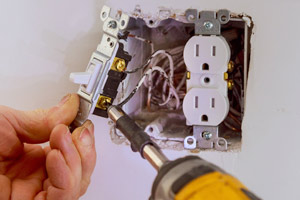
- Look for rust, water stains, soot stains, or melted wires at the service panel.
- Check the circuit breakers and see that they are properly labeled.
- Do a quick check to verify that the labeled circuit is actually the correct circuit by switching off the breaker and trying some of the devices connected to that circuit. If it’s not correctly labeled, re-label it and investigate the remaining circuits.
- Circuit breakers have three positions: “ON”, “OFF,” and “tripped.” Circuit breakers will trip, or shut down, if they exceed the maximum allowed current, typically 15 to 20 Amps.
- If any breakers are tripped, switch them to “OFF” then back to “ON.” If the breaker trips again, unplug all devices on that circuit.
- If this corrects the problem, then there are too many devices plugged in to this circuit or one of the devices or cords is faulty, unsafe, and leaking electrical current.
- If the breaker continues to trip, consult with a qualified electrician as necessary.
- Check all GFI outlets and breakers. Push the “TEST” button at least once a month to trip the circuit.
- If the “RESET” button doesn’t pop outward during this test, consult with a qualified electrician, as necessary, to replace the GFI switch.
- If it does pop out, push it back in and repeat next month.
- Do not plug refrigerators or freezers into a GFI circuit. These appliances experience sudden large power draws, which can trip the GFI switch and spoil the food!
- In general, keep tree limbs away from any overhead power lines.
- Always call your electrical utility service to locate underground power lines before digging any trenches or holes.
- If an electrical outlet doesn’t work, see if it’s controlled by a switch, GFI switch, or if the breaker has tripped, before calling an electrician.
- Don’t use light bulbs with a higher wattage than the fixture allows.
- Avoid changing exterior light bulbs in the rain.
- Never overload extension cords or use too many when bringing power to a remote device or fixture. Check the label for restrictions.
- Plug sensitive electronic devices such as televisions, computers, and printers into appropriate surge protector strips. Unplug them during lightning storms. If there are small children in the home, install outlet protector guards to keep out little fingers and paper clips.






